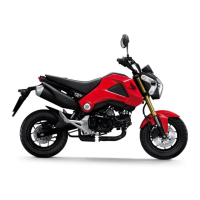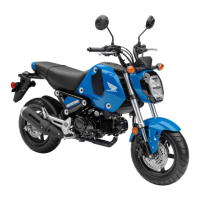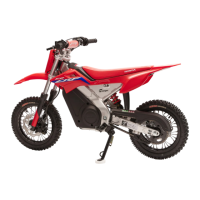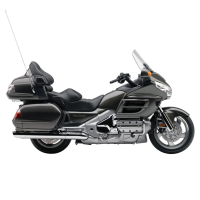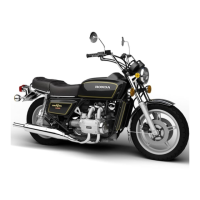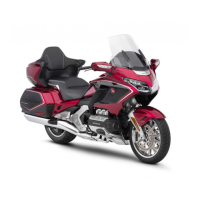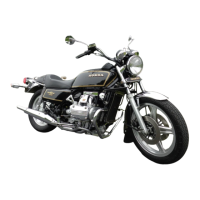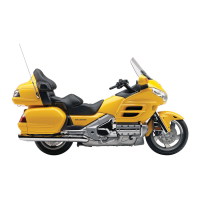Do you have a question about the Honda GROM125/A and is the answer not in the manual?
Guidelines to enhance safety, covering inspections, fuel safety, and avoiding hazardous areas.
Information and safety labels on your vehicle warn of potential hazards; do not remove them.
Precautions to ensure safety, including riding cautiously and protective apparel.
Precautions for riding, including break-in period, brakes, and wet conditions.
Advice against unauthorized accessories or modifications that can make the vehicle unsafe.
Guidelines for proper loading to maintain vehicle handling, braking, and stability.
Step-by-step guide to basic vehicle operation, from pre-ride inspection to starting and riding.
Procedures for effective braking and safe stopping or pulling over.
Techniques for safe cornering, including braking and throttle application.
Proper parking techniques and safe fuel handling procedures.
Diagrams identifying key vehicle components and their locations.
Details on the instrument panel functions, indicators, and settings.
Explanation of various indicator lights on the instrument panel and their meanings.
Description and function of all handlebar and ignition switches.
Step-by-step guide for starting the engine, including troubleshooting.
Explanation of the gear shift pattern and recommended shift points.
Procedures for safely opening and closing the fuel fill cap.
Information on the helmet holder and document bag locations and usage.
Explains why maintenance is essential for safety, performance, and longevity.
Specifies maintenance requirements for safe and dependable performance.
Template for recording maintenance performed on the vehicle.
Provides foundational knowledge and procedures for vehicle maintenance.
Advice on using genuine parts and warnings against non-genuine parts.
Information on battery type, maintenance, cleaning, charging, and emergency procedures.
Information on inspecting and replacing fuses, with warnings about improper replacements.
Guidance on selecting, checking, and adding engine oil.
Instructions for checking brake fluid levels and recommended fluid types.
Procedures for inspecting, cleaning, and lubricating the drive chain.
Detailed guide on inspecting tire pressure, damage, wear, and tread depth.
Procedures for removing and installing body components like the battery and seat.
Procedures for inspecting brake pads and adjusting the brake light switch.
Procedure for checking the side stand operation and lubrication.
Procedures for checking and adjusting clutch lever freeplay.
Procedure for checking throttle rotation, smoothness, and freeplay.
Diagnostic steps for when the engine fails to start or the starter motor doesn't operate.
Interpretation of PGM-FI and ABS indicators and necessary actions.
Understanding fuel gauge failure indications and their implications.
Guidance on emergency tire repair and the risks associated with temporary repairs.
Troubleshooting steps for common electrical issues like dead batteries and blown fuses.
Possible causes and solutions for unstable engine operation while riding.
Information on ignition keys, key numbers, and making duplicates.
Details on ignition switch, engine stop switch, odometer, and ignition cut-off system.
Guidelines for cleaning, washing, and maintaining the vehicle's appearance.
Recommendations for storing the vehicle for extended periods.
Guidelines for safely transporting the vehicle on trailers or trucks.
Advice on using sensible cleaners and recycling wastes to protect the environment.
Importance of VIN and engine serial numbers for registration and parts ordering.
Information on exhaust and noise emission requirements and systems.
Function of the catalytic converter and guidelines to protect it.
Information on approved fuel blends and potential issues with oxygenated fuels.
List of available manuals and how to order them.
Details on vehicle warranties, responsibilities, and recommended service practices.
Contact information for Honda customer relations and dealers.
How to report safety defects to NHTSA and Transport Canada.
Key physical dimensions, weight, capacity, and basic component specifications.
Detailed technical data including tire size, air pressure, spark plug, oil, and chain specifications.
Specifications for all vehicle bulbs, including type and wattage.
Specifications for main and other fuses used in the vehicle.
Guidelines to enhance safety, covering inspections, fuel safety, and avoiding hazardous areas.
Information and safety labels on your vehicle warn of potential hazards; do not remove them.
Precautions to ensure safety, including riding cautiously and protective apparel.
Precautions for riding, including break-in period, brakes, and wet conditions.
Advice against unauthorized accessories or modifications that can make the vehicle unsafe.
Guidelines for proper loading to maintain vehicle handling, braking, and stability.
Step-by-step guide to basic vehicle operation, from pre-ride inspection to starting and riding.
Procedures for effective braking and safe stopping or pulling over.
Techniques for safe cornering, including braking and throttle application.
Proper parking techniques and safe fuel handling procedures.
Diagrams identifying key vehicle components and their locations.
Details on the instrument panel functions, indicators, and settings.
Explanation of various indicator lights on the instrument panel and their meanings.
Description and function of all handlebar and ignition switches.
Step-by-step guide for starting the engine, including troubleshooting.
Explanation of the gear shift pattern and recommended shift points.
Procedures for safely opening and closing the fuel fill cap.
Information on the helmet holder and document bag locations and usage.
Explains why maintenance is essential for safety, performance, and longevity.
Specifies maintenance requirements for safe and dependable performance.
Template for recording maintenance performed on the vehicle.
Provides foundational knowledge and procedures for vehicle maintenance.
Advice on using genuine parts and warnings against non-genuine parts.
Information on battery type, maintenance, cleaning, charging, and emergency procedures.
Information on inspecting and replacing fuses, with warnings about improper replacements.
Guidance on selecting, checking, and adding engine oil.
Instructions for checking brake fluid levels and recommended fluid types.
Procedures for inspecting, cleaning, and lubricating the drive chain.
Detailed guide on inspecting tire pressure, damage, wear, and tread depth.
Procedures for removing and installing body components like the battery and seat.
Procedures for inspecting brake pads and adjusting the brake light switch.
Procedure for checking the side stand operation and lubrication.
Procedures for checking and adjusting clutch lever freeplay.
Procedure for checking throttle rotation, smoothness, and freeplay.
Diagnostic steps for when the engine fails to start or the starter motor doesn't operate.
Interpretation of PGM-FI and ABS indicators and necessary actions.
Understanding fuel gauge failure indications and their implications.
Guidance on emergency tire repair and the risks associated with temporary repairs.
Troubleshooting steps for common electrical issues like dead batteries and blown fuses.
Possible causes and solutions for unstable engine operation while riding.
Information on ignition keys, key numbers, and making duplicates.
Details on ignition switch, engine stop switch, odometer, and ignition cut-off system.
Guidelines for cleaning, washing, and maintaining the vehicle's appearance.
Recommendations for storing the vehicle for extended periods.
Guidelines for safely transporting the vehicle on trailers or trucks.
Advice on using sensible cleaners and recycling wastes to protect the environment.
Importance of VIN and engine serial numbers for registration and parts ordering.
Information on exhaust and noise emission requirements and systems.
Function of the catalytic converter and guidelines to protect it.
Information on approved fuel blends and potential issues with oxygenated fuels.
List of available manuals and how to order them.
Details on vehicle warranties, responsibilities, and recommended service practices.
Contact information for Honda customer relations and dealers.
How to report safety defects to NHTSA and Transport Canada.
Key physical dimensions, weight, capacity, and basic component specifications.
Detailed technical data including tire size, air pressure, spark plug, oil, and chain specifications.
Specifications for all vehicle bulbs, including type and wattage.
Specifications for main and other fuses used in the vehicle.
| Engine Type | Single-cylinder, four-stroke |
|---|---|
| Displacement | 124.9 cc |
| Bore x Stroke | 52.4 mm x 57.9 mm |
| Compression Ratio | 9.3:1 |
| Starter | Electric |
| Final Drive | Chain |
| Rear Suspension | Single shock |
| Front Tire | 120/70-12 |
| Rear Tire | 130/70-12 |
| Wheelbase | 47.2 inches |
| Seat Height | 30.0 inches |
| Fuel System | PGM-FI |
| Transmission | 5-speed |
| Front Suspension | 31mm inverted fork |
| Front Brake | Single 220 mm disc with two-piston caliper |
| Rear Brake | Single 190mm disc with hydraulic single-piston caliper |
| Fuel Capacity | 1.45 gallons |
| Curb Weight | 227 pounds (Includes all standard equipment, required fluids and full tank of fuel-ready to ride) |
